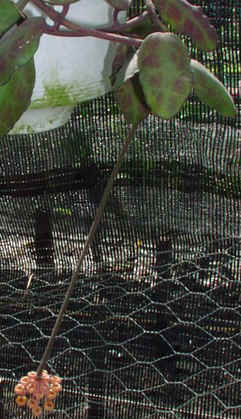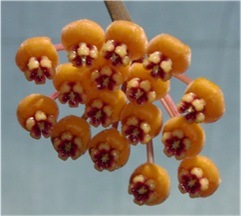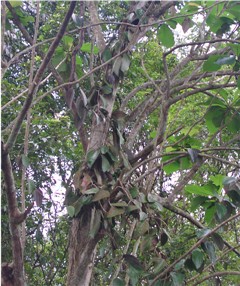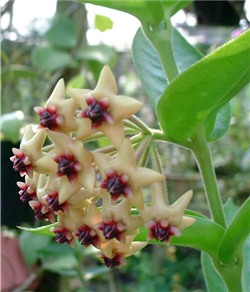 |
The
flowers of H. obtusifolia smells like mango but they never open
fully, prefering instead to form drooping claws. This is a large thick
vine the likes of H. diversifolia but is much rarer and grows very high up
in the canopy. This plant was collected from Peninsula Malaysia from a
fallen tree where it was climbing rampantly all over its trunk. The
vegetative feature does not look like a typical Hoya al all. |

|
The
heavy flowers of Hoya mitrata from Thailand, Borneo and Malaysia.
Like its relative H. darwinii, this species has 2 types of leaves, the
normal type and the cabbage-type - the latter attracts ants to build nests
there. The leaves are large, thick and lightly streaked with white.
Contrary to Rintz comments about the species, the form I have is very free
flowering whole year through - the essence to success is strong light and
good watering. |
|

|
Hoya waymaniae is a new species from Borneo
described by Dale Kloppenburg. The leaves are very thick and turn red in
the sun. The orange bloom was borned on a long peduncle. This species
appears to rot easily so watering needs to be controlled. The peduncle
tends to drop off after flowering.

|
|


|
The thin hard leaves of H.
caudata appear to be lichen covered. This is a very slow vine and has been
found in Malaysia, Thailand and Borneo. The flower is very distinguished,
having ciliate hairs emerging from corona. |
|

|
Hoya macrophylla is a large leaf
species from SE Asia. It is also a common plant in Singapore, where I have
seen plants laden with heavy succulent leaves measuring around 15 x 23cm.
Singapore plants (pictured left) appear to have rotund leaves while in mainland Malaysia,
the leaves are more elongated |
|

|
H. hypolasia is one of the many interesting
Hoyas species Schlecter had described from PNG. This has a dark hairy wiry stem and soft long
hairy
leaves shown in the 2 above photos. The plant is not fast growing and cuttings may take some time before becoming established.
|
|

|
Hoya densifolia is from the Philippines and has
similar shrubby habit as H. multiflora. |







